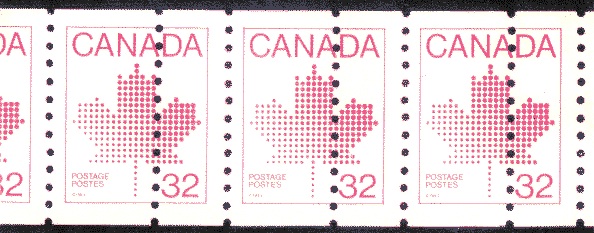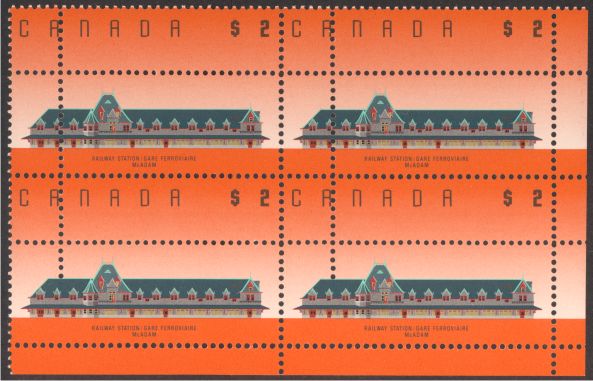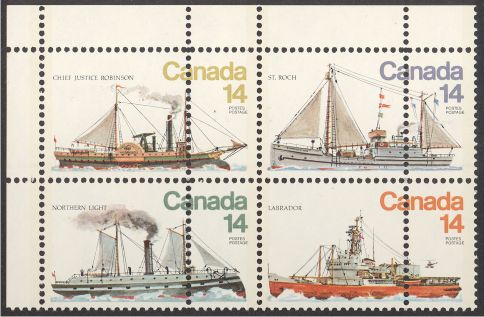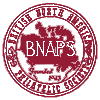Fake Double Perf Coils Uncovered
John Jamieson and Leopold Beaudet
(This is an updated version of an article published on the Saskatoon Stamp Centre website in May 1997. The 1997 article appeared in many philatelic journals and papers since it was released.)
How much would you pay for one of the coil strips with double perforations shown here? Read on before making an offer!



Figure 1. Three strips of coils with fake double perforations acquired by John Jamieson of Saskatoon Stamp Centre a) 1976 10¢ QE II Caricature, b) 1978 14¢ Parliament, c) 1983 32¢ Maple Leaf
At the Great Western Stamp Show held in Richmond, BC, on 14-16 February 1997, dealers were approached by an individual from Burnaby, BC, with a stock book brimming with double perforation varieties. The stock book included strips of most coils issued since the 1973 Caricature issue. Although the varieties looked genuine, dealers Gary J. Lyon of Bathurst, NB, and John Jamieson of Saskatoon Stamp Centre, a co-author of this article, were immediately suspicious because of the large quantity of material being offered. As it turns out, all the double perf coils were fakes. John Jamieson deliberately acquired some of the material, the strips illustrated in this article, to provide evidence of the fakes.
The strips of coils offered at the Richmond show had 13 stamps with double perforations. There was even a strip of 13 of the 1983 32¢ Maple Leaf coil with two extra rows of perforations, a triple perf “variety”. However, all the coils from the 1969 6¢ orange Centennial coil onwards are perforated just 12 rows at a time. This is borne out by imperforate coil varieties that usually have 12 rows of perforations missing and by irregularities just as bent perforation pins which repeat after every 12 rows.
An imperforate coil strip caused by a missing strike of the perforator affects 13 stamps. 11 stamps are completely imperforate and 2 are imperforate on one side only. Whoever produced these fakes must have thought that since a missing strike affects 13 stamps, an extra strike should also affect 13.

Figure 2. “A” Maple Leaf coil with fake double perforations acquired by John Jamieson
The “A” coil John Jamieson acquired has a second anomaly that proves it is a fake. The strip is illustrated with two sets of numbers above it and one set below. The numbers beginning with “F” refer to the fake perforations, the “P” numbers refer to the genuine perforations, and the “S” numbers refer to the stamps. The stamp numbers go up to 36 and then start over at 1. The stamps are numbered this way because there is a design jump between stamps “S36” and “S1”. All coils from the 6¢ orange Centennial onwards are printed from two plates each with 36 rows by 20 columns of stamps. Each plate is fixed to a printing cylinder, and forms an arc around it. Where the two plates meet, there is usually a design jump or spacing variety between the last stamp on one plate and the first on the next. The design jump on the “A” strip appears as a slight (0.5 mm) downwards shift of stamp “S1” relative to stamp “S36”.
The coils also have “perforation jumps” after every 12 rows of perforations caused by misalignments between successive strikes of the perforator. The perforation jump on the “A” strip occurs on stamp “S4”. The perforations to the left of stamp “S4” are all centred whereas the perforations to the right of “S4” are shifted to the left causing the stamps to be off-centred. Because of the shift, stamp “S4” is smaller than normal. All the perforations up to “P12” belong to one strike of the perforator, and those numbered from “P1” on belong to the next strike. There is also a minor spacing irregularity in the normal perforations beginning at “P7”. At this point, the perforations are shifted slightly to the right. This is not caused by a strike misalignment, but rather by a spacing variation in the rows of pins.
On the “A” strip, the fake perforations are always exactly the same distance from the normal perforations to the right of them. If the same perforator produced the normal and extra perforations, this would be impossible. To see why, consider the spacing irregularity between “P12” and “P1” caused by the strike misalignment. The fake row of perforations at “F6” is the same distance from “P1” as “F5” is from “P12”. This means that there is a spacing irregularity in the fake perforations between “F5” and “F6”. However, if rows “F5” and “F6” are in the middle of the perforator, a strike misalignment could not possibly occur at this point. Ergo, the spacing irregularity in the extra perforations should not exist.
The spacing anomaly in the extra perforations implies that they were produced one row at a time unlike the normal perforations which were produced 12 rows at a time. The faker took pains to position each row of extra perforations at precisely the same distance to the left of the normal ones, thus inadvertently mirroring the spacing irregularities in the normal perforations. He did not realise that he was reproducing a strike misalignment in the middle of the supposed extra strike!

Figure 3. Magnified view of the 32¢ Maple Leaf coil showing crooked holes in the normal perforations
There is another anomaly on the 32¢ Maple Leaf coil. As shown in the magnified view, the regular perforations have one or more crooked holes in most rows, the result of bent perforation pins. However, there are no such irregularities in the rows of extra perforations. All the extra holes are perfectly aligned. Obviously, the regular and extra perforations were not produced by the same perforator.

Figure 4. 6¢ Pearson Caricature definitive with extra vertical and horizontal
perforations, acquired from the same source as the fake double perf coils
The individual offering the coils at the Richmond show also had several blocks of the 1973 6¢ Pearson Caricature definitive including a lower left plate block with the horizontal and vertical perforations doubled. Given its source, the chances that it is a fake are very high but, unlike the coil strips, there are no known anomalies to prove it.

Figure 5. BABN printing of the 1989 $2.00 McAdam Railway Station with fake extra perforations in both directions
A similar “variety” exists on the 1989 $2.00 McAdam Railway Station definitive offered in a March 1996 auction by Regency Stamps Ltd. of St. Louis, Missouri. In this case, there is no doubt that the extra perforations are fake. The $2.00 McAdam stamp was first printed by B. A. Banknote Co. (BABN) who perforated it by feeding sheets vertically through a 2-row comb perforator. The perforating technique is confirmed by a spectacular missing strike error described in the 2 January 1990 issue of Canadian Stamp News. In 1992, Canadian Bank Note Co. (CBN) took over the printing duties, and perforated the stamp by feeding sheets sideways through a 1-row comb perforator. The short column of the extra vertical holes in the bottom row of stamps might have been produced by the CBN sideways perforation. The hole pattern could not possibly have been produced by the BABN vertical perforation. Unfortunately for the faker, he chose to ply his craft on a block with the unmistakable characteristics of the BABN printing.

Figure 6. 1978 14¢ Ice Vessels with fake vertical perforations
Over the years, other fake extra perforation varieties have appeared on the market. The 14¢ Ice Vessels quartet issued on 15 November 1978 was printed by Canadian Bank Note Co. and perforated using a comb perforator. In 1979, two panes of 50 and several blocks such as the one shown appeared in dealer ads and auction catalogues. All the examples had extra vertical perforations but no extra horizontal ones. Given that the stamps were comb perforated, the fake is easy to detect. The extra vertical perforations do not line up with normal horizontal ones where they intersect. If the extra perforations had been produced with a comb perforator, there would also be extra horizontal perforations. Since there aren’t any, the extra vertical perforations could not have been produced by the comb perforator used by the stamp printer, and thus the “variety” is a fake.
Similar fakes are known on the CBN printing of the 1977 1¢ and 2¢ Floral definitives. They were offered in a June 1994 auction conducted by Jim A. Hennok Ltd., and were clearly identified as fakes in the auction catalogue.
In a December 1996 auction, Paradise Valley Stamp Co., Inc., of Scottsdale, Arizona, had a lower left plate block of four of the 1989 $2.00 McAdam definitive with a similar extra perforation “variety”. The auctioneer, Mr. Torbjorn Bjork, withdrew the lot from the auction because the extra perforations were fake. Like the 14¢ Ice Vessels quartet, the vertical perforations are doubled but there are no extra horizontal perforations.
Mr. Bjork withdrew several other extra perforation lots from the December 1996 Paradise Valley Stamp Co. auction because they were all consigned by the same person as the $2.00 McAdam “variety”, someone from the Toronto area, and they all appeared to be fake. The lots included a peculiar part imperforate variety on the Hong Kong 1968 $1.00 Coat-of-Arms definitive and several examples of British Commonwealth King George V and VI stamps perforated “SPECIMEN”, both straight line and horseshoe shaped. Mr. Bjork also rejected some high value 1898 Jubilee stamps from the same individual because they were proofs perforated to look like the issued stamps. Collectors of classic material, take note!

Figure 7. Fake part imperforate “variety” on the 1958 5¢ Samuel de Champlain
commemorative
(digital reconstruction)
In 1995 and 1996, two prominent Toronto auction houses and one in Hong Kong offered several peculiar part imperforate varieties on Canadian stamps similar to the Hong Kong piece withdrawn by Mr. Bjork. They included: 1) a strip of three of the 1958 5¢ Samuel de Champlain commemorative; 2) a strip of three of the 1959 5¢ Royal Visit stamp; and 3) a strip of four of the 1964 5¢ Royal Visit issue. In all three cases, the top or bottom of the strip appears to be imperforate except for part of the rightmost stamp. One of the Toronto auction houses also offered an item from Hong Kong, a strip of four of the 1962 $1.00 QE II definitive imperforate at bottom except for part of the rightmost stamp, and several British Commonwealth stamps perforated “SPECIMEN”. The auctioneer refused to handle subsequent extra perforation material submitted by the consignor. The Hong Kong auctioneer offered at least two more part imperforate strips on Hong Kong stamps.
The part imperforate strips were faked by carefully trimming one side of the stamps just short of where the normal perforations would start to appear. Fake perforation holes were added on part of one stamp presumably to make the strips look like an unusual perforation variety rather than what they are, namely, normal stamps with one edge trimmed. The fakes are especially obvious on the Hong Kong stamps because they were comb perforated. On a comb perforated stamp, the spacing between adjacent rows of perforations is fixed; however, on all four Hong Kong examples, the partial row of perforations is one hole too close to the normal perforations on the other side of the stamp. The peculiar part imperforate “varieties” began appearing on the market about two years ago, although the stamps are 25 to 40 years old. In no case does a “proving block” (that is, a block with stamps that are part imperforate between) exist, nor have other parts of the part imperforate strips been offered for sale.
On all the fake perforation varieties, the perforation holes look like the normal ones. The extra holes are the same diameter as the normal ones, the shape of the holes looks normal, the spacing between the holes appears correct, and the perforation gauge is identical. All the fake extra perforation varieties were detected because it was impossible for the perforator that produced the normal perforations to produce the extra ones. On the coils, for example, the fact that there are 13 rather than 12 rows of extra perforations is key to detecting the fakes. On the 14¢ Ice Vessels, the fact that the extra perforations occur in just one direction but do not line up with the normal holes where they intersect clearly proves the “variety” is a fake. On the part imperforate “varieties”, the fact that the “imperforate” margins are trimmed too close to the stamps and the fact that the holes on the part imperforate side are too close to the holes on the other side of the stamp give the fakes away. In all these cases, the extra holes themselves look like the normal ones.
The fact that the fake perforation holes look normal has some disturbing ramifications for variety collectors. One can surmise that an extra perforation variety is probably fake if it has an anomaly that a normal perforator could not have produced, but it appears to be impossible to prove conclusively that an extra perforation variety is genuine. For example, a strip of 13 coils with extra perforations is evidently fake, but if the strip is separated into pairs or strips of 4, the evidence vanishes. The extra perforations on the 6¢ Caricature definitive are even more disturbing. The extra perforations look genuine; however, given the source, how could anyone accept the variety at face value and pay a premium for it? Given the sophistication of the fake perforations, how can one be sure of the genuineness of ANY extra perforation variety? The short answer is: one can’t.
Even the stamp expertization committees have had problems with extra perforations on coils. In 1996, two pairs of the 1983 32¢ Maple Leaf coil with two rows of extra perforations were submitted to the Vincent Graves Greene Philatelic Research Foundation. In both cases, the Foundation issued certificates stating that the varieties were genuine. However, John Jamieson spotted a strip of the 32¢ coil with two rows of double perforations on 13 stamps among the extra perforation coils at the Richmond show. Although the pairs submitted to the Foundation could be genuine, it is doubtful that anyone could prove it unequivocally. In 1995, the Comité d’Expertise de la Fédération Québécoise de Philatélie issued a certificate stating that a strip of 17 of the 1978 14¢ Parliament coil with double perforations on 13 stamps was genuine. Unfortunately, the expertization committee either did not count the number of stamps with doubled perforations or did not appreciate the significance of there being 13 rather than 12.
The fact that good fakes of British Commonwealth stamps perforated “SPECIMEN” are showing up should raise a cautionary flag with Canadian collectors of perforated “OHMS” stamps produced by the federal government between 1912 and 1947. Dangerous fakes of the perforated OHMS varieties were discovered in large numbers as far back as 1978 and 1979.
The authors know of several extra perforation varieties that were found at post offices. These discoveries are unquestionably genuine. However, once the discovery is publicised and a photograph is published, what’s to prevent a faker from producing imitations of the discovery?
With the printing of this story, the problem of distinguishing genuine from fake grows even more acute. On the one hand, this story provides you the reader with some ammunition for detecting fakes. On the other hand, the faker can use this same story as a guide to correct his mistakes and produce fakes that look even more convincing. Unfortunately, unless some way can be found to positively identify all fake perforations, EVERY extra perforation variety must be suspect.
A final note from John Jamieson
As the owner of the Saskatoon Stamp Centre, I have bought and sold many double perf “varieties” over the years. With this discovery, it is now painfully clear that some of them were likely fakes. Others that are likely perfectly fine are now highly suspect. Anyone who has ever purchased any such “varieties” from the Saskatoon Stamp Centre is asked to please contact us. Sort of a Philatelic “Recall” notice. Whether it is one of the “obviously guilty” double perf fakes or even if it is one we feel is “OK”, but you are feeling a bit uneasy about your investment, please contact us. If you are the least bit concerned about your purchase, we will gladly refund your money. Regardless, we want to discuss what you obtained through us and establish what you have. At the Saskatoon Stamp Centre we guarantee everything to be genuine, forever.
Copyright © 1997, 2021 John Jamieson and Leopold Beaudet
Web design copyright © 2013-2026 The British North America Philatelic Society.
The documents on this website are for informational and non-commercial or personal use only.
Documents on this website shall not be used on other websites or for commercial purposes without permission.
This page was last modified on 2021-12-20
